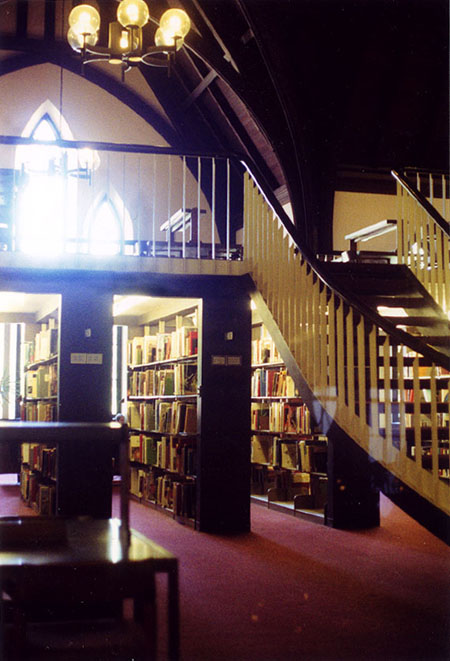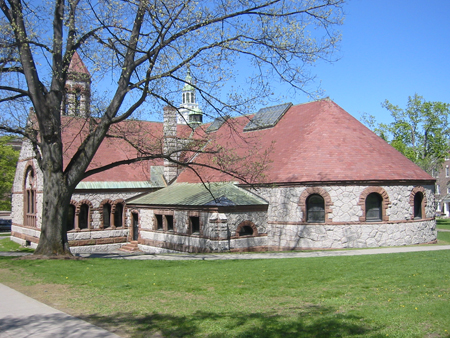The seeming underuse of Rollins Chapel prompts one to ask whether it is finally time to devote the building to a more productive function; whether Dartmouth, without damaging the building or making a change that cannot be undone, should use Rollins for some purpose that serves the academic mission of the school.
Rollins would make a fantastic library reading room or simply a study space, for example. Students would actually have a reason to experience the building on a regular basis and appreciate its recent restoration.
Churches have been turned into libraries at Haverford College in Pennsylvania (below); at St. Edmund’s Hall in Oxford (St. Peter in the East, see interior photo provided by the college); and at Lincoln College in Oxford (All Saints Church, see interior photo by Martin Beek). And from the photos (more), the Modernist bookstore inserted by Merkx + Girod into a 13th century church in Maastricht is simply astounding.

Dartmouth would continue to provide worship space, especially for student religious groups that do not have independent student centers and denominational chapels somewhere in town. There is little reason, however, for this generic worship space to occupy a prime site at the heart of a secular institution. To use its resources efficiently and help keep its most-used buildings within ten minutes of the Green, Dartmouth could easily justify the removal of its official worship space to a site that is relatively cheap and distant.
Dartmouth might consider building a noble and uplifting timber-framed building, simple and undecorated — perhaps in the form of an octagonal or round barn (Wikipedia), a vast English aisled barn (like Harmondsworth Great Barn, in Wikipedia), or a discount version of Thorncrown Chapel. The building might stand between EKT and Tri-Delt, or it could occupy one of the vacant sites west of the President’s House. It would be the sort of place where alums could hold weddings and the college could hold memorials.
Once the new hall opens, the college could sensitively furnish Rollins as a study space, like the ’02 Room, or as a new home for one of the smaller libraries.

Removing the recent interior lights from the roof trusses would take Rollins closer to its original appearance, and replacing the existing movable chairs with high-quality lighted study tables or carrels would make Rollins into a highly useful building.
——
[Update 05.12.2013: Broken link to Merkx-Girod replaced, additional Maastricht photo link added.]
[Update 11.04.2012: Jacobs Consultancy, a firm working with the college on the new master plan, provides
detailed analysis and feasibility testing of the activities and occupants of a facility or complex, coupled with the analysis of existing buildings, their current, plus potential capabilities and capacities. This process identifies shortfalls and excesses in spaces controlled by various occupant groups, and suggests “highest and best use” scenarios with matches and mismatches by current occupants.
It will be interesting to see what they say about Rollins Chapel.]
Those of us who live in Hanover know that Rollins gets used a lot, and not just for undergraduate religious services. Alumni are married there. It’s used for funerals of alumni and non-alumni who may not have a local church or synagogue affiliation. Or need a meditative space that seats more people than some of the small religious buildings. It’s a good concert space too.
Speaking of having a chapel at the center of campus, it is interesting to note that on each of the three occasions since 1790 when Dartmouth has replaced its unsuitable old chapel, it has moved the chapel function farther from the center of campus. One of those redundant chapels became a barn, and another became an auditorium.
The most common way to reuse an unneeded church these days seems to be to turn it into an auditorium, but some of the most interesting reuses for redundant churches I’ve seen are the Freud Restaurant in Oxford (a 19th-century Classical church, Wikipedia image) and the Resurrect Art Coffee House in Seward Alaska (a 1916 shingled Gothic church).
See also the update to the original post, added after the comments above were published.
Look, I too once found it unthinkable that Rollins could ever be deconsecrated or used entirely (instead of partially) for non-religious purposes. That’s why the post is somewhat brusque: what I’m biased against is waste. Dartmouth’s planners seek efficiency too, which is why it’s time to start thinking about Rollins as what it is — a wonderful, central, adaptable building.
There is no disputing the fact that Rollins is extremely underused for its location. Rollins was built for mandatory Christian chapel services, not for voluntary worship in a faith of one’s choosing. Dartmouth stopped punishing students for skipping chapel in 1925, and since then the Catholic, Episcopal, Lutheran, United Church of Christ, Christian Scientist, Jewish, Quaker, and Muslim groups have all arranged to use worship spaces some distance from Rollins. All that’s left seems to be the Tucker Foundation, which holds a few services a week in Rollins (Ecumenical Christian, Jewish Shabbat, and Muslim Salaat), and some student groups (the Orthodox Christian Fellowship and presumably others).
These and other religious uses are valuable and should be supported, which is why the post proposes that they be given an exclusively religious and architecturally nonsectarian home for the first time. A noble, uplifting sanctuary could be adorned appropriately by each group that uses it and wouldn’t be “owned” by any of them. As important as these religious activities are to student life, however, they do seem to be less important to Dartmouth’s present-day academic mission than the provision of sufficient study space within a half-mile of Baker. The post is not about religion as much as walkability.
It seems like your anti-religious/anti-faith bias is showing.
Rollins is used significantly. Faith groups are the fastest growing student organizations on campus, and many use Rollins.
Even if this were not the case, it would be embarrassing not to have a chapel in the center of campus. Next you’ll want to turn Pine Park into a parking lot because not many students take advantage of Pine Park any more.